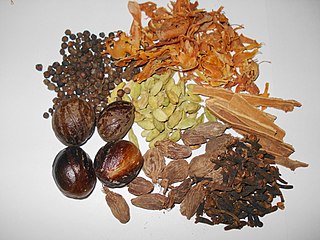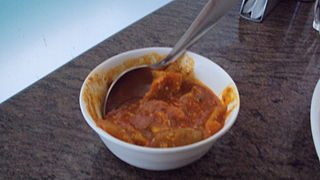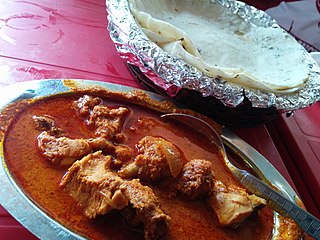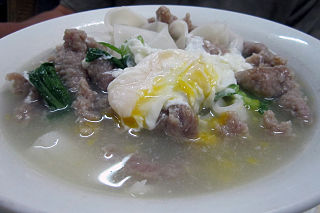
Cheez Whiz is a brand of processed cheese sauce or spread produced by Kraft Foods. It was developed by a team led by food scientist Edwin Traisman (1915–2007). It was first sold in 1952, and with some changes in formulation continues to be in production today.

Spice mixes are blended spices or herbs. When a certain combination of herbs or spices is called for in a recipe, it is convenient to blend these ingredients beforehand. Blends such as chili powder, curry powder, herbes de Provence, garlic salt, and other seasoned salts are traditionally sold pre-made by grocers, and sometimes baking blends such as pumpkin pie spice are also available. These spice mixes are also easily made by the home cook for later use.

Adobo or adobar is the immersion of cooked food in a stock composed variously of paprika, oregano, salt, garlic, and vinegar to preserve and enhance its flavor. The Portuguese variant is known as carne de vinha d'alhos. The practice, native to Iberia, was widely adopted in Latin America, as well as Spanish and Portuguese colonies in Africa and Asia.

Tamil cuisine is a culinary style of Tamil people originating in the southern Indian state of Tamil Nadu and neighboring Sri Lanka. Meats, along with rice, legumes, and lentils, are also popular. Dairy products and tamarind are used to provide sour flavors. On special occasions, traditional Tamil dishes are served in a traditional manner, using banana leaves in place of utensils. After eating, the banana leaves are then used as a secondary food for cattle. A typical breakfast meal consists of idli or dosa with chutney. Lunch includes rice, sambar, curd, kuzhambu, and rasam.

Levantine cuisine is the traditional cuisine of the Levant, in the sense of the rough area of former Ottoman Syria. The cuisine has similarities with Egyptian cuisine, North African cuisine and Ottoman cuisine. It is particularly known for its meze spreads of hot and cold dishes, most notably among them ful medames, hummus, tabbouleh and baba ghanoush, accompanied by bread.

Onion powder is dehydrated, ground onion that is commonly used as a seasoning. It is a common ingredient in seasoned salt and spice mixes, such as beau monde seasoning. Some varieties are prepared using toasted onion. White, yellow and red onions may be used. Onion powder is a commercially prepared food product that has several culinary uses. Onion powder can also be homemade.

Chili sauce and chili paste are condiments prepared with chili peppers.

South Asian pickles, also known as Lonache, Avalehikā, Uppinakaayi, Pachadi or Noncha, Achaar, Athāṇu or Athāṇo or Athāna, Khaṭāī or Khaṭāin, Sandhan or Sendhan or Sāṇdhāṇo, Kasundi, or oorugaai is a pickled food made from a variety of vegetables and fruits preserved in brine, vinegar, edible oils, and various Indian spices. The pickles are popular across the Indian subcontinent, with many regional variants.

Garlic powder is a spice that is derived from dehydrated garlic and used in cooking for flavour enhancement. The process of making garlic powder includes drying and dehydrating the vegetable, then powdering it through machinery or home-based appliances depending on the scale of production. Garlic powder is a common component of spice mix. It is also a common component of seasoned salt.

Mujdei is a traditional spicy Romanian sauce. It is made from garlic cloves crushed and ground into a paste, salted and mixed energetically with vegetable oil. Depending on regional preferences and the dish it is served with, lemon or other ingredients may be added. The result is a white sauce with a strong garlic flavor, varying in consistency from a thick paste to a runny sauce. In some parts of Romania mujdei is made out of cream, ground garlic, and salt. Sometimes ground garlic, salt, little water, oil and paprika powder.

Batata vada is a popular vegetarian fast food dish from the Indian state of Maharashtra. The dish consists of a mashed potato patty coated with chick pea flour, which is then deep-fried and served hot with chutney. The vada is typically around two or three inch in diameter. Across different regions of India, this dish is also known as aloo bonda, aloo vada, batata bonda, potato bonda and potato vada.

Chicken curry is a dish originating from India. It is common in the Indian subcontinent, Southeast Asia, Great Britain, Caribbean, and Japan. A typical curry from the Indian subcontinent consists of chicken stewed in an onion- and tomato-based sauce, flavoured with ginger, garlic, tomato puree, chilli peppers and a variety of spices, often including turmeric, cumin, coriander, cinnamon, and cardamom. Outside of South Asia, chicken curry is often made with a pre-made spice mixture known as curry powder.

Kyay oh is a popular noodle soup made with pork and egg in Burmese cuisine. Fish and chicken versions are also made as well as a "dry" version without broth. Kyay oh is traditionally served in a copper pot. Kyay oh is made with rice noodles and marinated meatballs. The broth is made with pork, chicken, or fish. The pork version, the most popular, uses pork bones and intestine. Kyay oh is typically served with a tomato and green pepper sauce.

Burmese salads are a diverse category of indigenous salads in Burmese cuisine. Burmese salads are made of cooked and raw ingredients that are mixed by hand to combine and balance a wide-ranging array of flavors and textures. Burmese salads are eaten as standalone snacks, as side dishes paired with Burmese curries, and as entrees. The iconic laphet thoke is traditionally eaten as a palate cleanser at the end of a meal.

Mu or Korean radish is a variety of white radish with a firm crunchy texture.

Kaeng hang le is a rich Northern Thai pork curry. Kaeng hang le is very popular in Northern Thailand, well-known as a specialty of the region. The curry differs from traditional northern Thai curries in several respects: it is typically eaten with long-grained rice, not sticky rice, and uses dried spices, which are commonly used in Burmese, but not northern Thai curries. The dish is commonly served as a festive dish in northern Thailand.
Kachin cuisine is food originating from the Kachinland area, which includes the northern areas of Myanmar, as well as parts of China and Arunachal Pradesh, associated with Kachin. Outside of Kachinland, Kachin restaurants have opened in Yangon, and Kachin migrants have brought the cuisine to other countries.
















